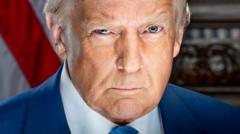The official portrait of Donald Trump, taken by his chief photographer Daniel Torok, has ignited conversations about the essence of political imagery. As critics note its serious, even ominous tone, the photograph portrays the president-elect with a stern expression, eyebrows raised, drawing attention to the artist's intentions.
Eric Draper, a former White House photographer, asserted that such portraits are pivotal, often becoming the most recognized images of a leader. His assessment of Trump's portrait reveals what he believes to be significant manipulation, with dramatic studio lighting employed to cast shadows and highlight Trump's features. Draper commented on the unsettling quality of the lighting—which he termed "monster" lighting—describing it as reminiscent of horror films.
Further analysis from portrait photographer Eliska Sky draws parallels between Trump’s look and that of an athlete about to engage in battle, emphasizing the seriousness conveyed by the setup. Paul Duerinckx, a photography lecturer, remarked on the unconventional light direction, which can evoke strong emotional responses from viewers, suggesting an intent behind the image that strays from conventional political portraiture.
In contrast to the lighter, more familiar image from 2017, which many characterized as displaying both Trump's business persona and charm, the current portrait aims to send a specific message. Political photographer Andrew Parsons highlighted its calculated nature, stating that it serves more as a direct communication than a casual representation.
The recent mug shot of Trump taken during his legal troubles has also stirred conversation. Photography YouTuber Jared Polin cited Torok's acknowledgment that this mug shot—widely circulated and recognized—provided some inspiration for the new portrait. This cultural crossover illustrates how even controversial moments can influence political imagery, asserting the lasting power of visual representation in context.
In an era where images hold immense sway in political dynamics, understanding the nuances of such photographs is crucial. As Parsons succinctly remarked, a single photograph can profoundly impact a political campaign, underscoring the power dynamics at play in visual storytelling.




















